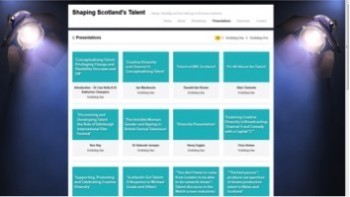Since debuting on the UK’s digital terrestrial television service Freeview in March 2015, I have been enthralled by the Horror Channel. Part of the reason for my enchantment is linked to my ‘aca-fan’ interests as from April 2014 to late March 2016, Horror had been re-running episodes of ‘classic’ Doctor Who (e.g. those initially-broadcast between 1963 and 1989) on a daily basis. This dovetailed nicely with research for my forthcoming monograph by allowing me to consider constructions of nostalgia arising from a transmedia context beyond the immediate confines of the BBC’s websites and portals. However, reflecting on ‘Who on Horror’ has also thrown up some interesting observations concerning the tensions that can arise between channel brands, corporate brand architecture and genre discourses. It is these issues that I want to discuss in this blog post, and by doing so I hope to make a case for the ongoing need to engage with a variety of channels and programming forms when discussing the continued importance of concepts like branding and genre to the television industry.
Many of the recent debates in TV Studies have continued to study branding, but this has become aligned with wider technological and taste-derived shifts resulting in a dominant focus on either originally-produced content, ‘high-end’ examples and/or streaming and subscription services (Nygaard 2013; Jenner 2014; Bottomley 2015). However, by engaging with Horror’s brand identity and the paratextual framing of the shows and movies that it transmits, I hope to make a case for also examining lesser-studied channels which repackage older films and television series in a competitive and digitised environment.

An official publicity image for ‘Who on Horror’
For those outside of the UK, or anyone who is yet to have encountered the network (for whatever reason that might be), allow me to introduce you. Horror is located on the outer registers of your EPG; on Freeview it is channel 70 and nestles anachronously between TruTV+1 and CBS Drama. In terms of ownership, the channel is a joint venture between the US-based organizations CBS Studios International and AMC Networks International. This pairing came about first as a result of CBS striking a deal to acquire four of the channel’s owned by global distributor Chellomedia in 2009 and rebrand (some of) these under the CBS name (Curtis 2009). Then, AMC chose to buy out the entire Chellomedia company five years later (Szalai 2014). Relating to industrial trends, Horror is therefore a product of the strategies currently being pursued by contemporary US media conglomerates. These include expanding the recognition and penetration of television brands like CBS within non-domestic markets as a result of the opportunities brought about by the increasingly globalized and deregulated television marketplace. As AMC Networks’ CEO Josh Sapan said in 2014, acquiring Chellomedia provides “significant long-range opportunities for AMC Networks to distribute its original programming from AMC, IFC, Sundance Channel and WE TV across an expansive global footprint.”

Horror’s ‘knowing’-yet-transgressive branding in announcing its move to Freeview
Horror is not the only network that this CBS/AMC hybrid currently transmits to the UK as others, which also adopt a singular generic focus such as CBS Reality, CBS Drama and CBS Action, make up their channel portfolio. What’s curious about Horror, though, is the distance maintained between the channel’s branding and CBS as the wider brand endorser. Reflecting on why this may be the case, and adopting a discursive understanding of genre similar to that developed by Jason Mittell (2004), points towards forms of cultural power operating around horror’s meanings as a televisual genre within a historical context when ‘horror television’ is more prominent than it has previously been. Why, then, is Horror not ‘CBS Horror’?
One possible way of accounting for this distance might be to address arguments rooted in a political economy framework. This is because CBS’s construction of its current brand architecture does, on the one hand, echo Simone Murray’s (2005: 422) argument that “Increasingly, there is a move away from emphasizing the globalized media conglomerate as the dominant brand (e.g. Time Warner) in favour of focusing on subsidiary enterprises as their own brands” Yet, on the other hand, resting on this understanding is inadequate because of CBS’s willingness to explicitly endorse the other networks which it distributes in the UK. Rather than settling on a political economy perspective, we need to address the cultural meanings of ‘horror on television’ and which of these are deployed by Horror. Doing this points towards dissonance between Horror’s encoding of the genre and CBS’s wider brand identity.
Horror’s construction of its namesake in marketing material foregrounds the genre’s transgressive, marginalised and subversive meanings to aid the channel’s appeal to a minority (masculinised) ‘cult’ audience. This construction of ‘horror on television’ is also combined with strong pulls towards constructing a shared viewing community, with the channel at the centre of this, as signified by the frequently-repeated tagline of ‘We are Horror’ (see the video below). Horror’s aligning of its channel brand with ideas of ‘cultishness’ and transgression also arguably extends beyond promotional material into other paratexts as well. Its location on the fringes of the EPG recalls the back-street cinemas and video stores where cult movies were traditionally screened (Hollows 2003) and its schedules further connote minority-interest. Throughout the day, Horror repeats old (primarily US) telefantasy shows like Land of the Giants (1968-70) alongside made-for-TV movies (Robin Hood: Beyond Sherwood Forest (2009), where Ginger Snaps’s (2000) Katherine Isabelle transforms into a dragon, has become a personal favourite). During the evening, an array of classic and cult horror films are then aired such as, in recent weeks, Lamberto Bava’s Demons (1985) and David Cronenburg’s Videodrome (1983). The cumulative effect of these elements represent a conscious recognition of Matt Hills’ (2005: 111) argument, developed in relation to different historical and technological contexts, that horror on television constitutes a ‘para-site’, “a cultural site that is assumed to be alien to the genre and a space where horror supposedly does not belong.”
Thus central to how Horror brands itself through embracing the genre’s historically-marginalised position on television is by avoiding discourses of “mass camp” (Brunsdon 2004: 119) nostalgia by framing the content that the channel re-runs in an ironic manner (as has historically been the case with re-run networks such as Nick at Nite – see Spigel 1995; Kompare 2005). This is not to argue that Horror doesn’t demonstrate reflexivity towards its tone and content – the active embrace of horror’s antagonistic history with television, alongside the knowing ‘wink’ evident in its publicity material, indicates this. However, I would argue that the reflexivity demonstrated by the channel brand works more to build a knowledgeable shared viewing community who are ‘in on the joke’ rather than ironize its content from the ‘enlightened’ perspective of the present. Evidence of this strategy can be demonstrated in various ways: the channel’s sophisticated and stylised idents work on the assumption that audiences will recognise its intertextual references to movies such as Hellraiser (Barker, 1987); continuity announcements demonstrate a respectful attitude towards what follows irrespective of its aesthetic limitations; movies are preceded by warnings about their controversial content and, at weekends, feature specially-shot pre-inserts where recognized horror aficionado Emily Booth playfully contextualises the forthcoming film by outlining its generic and/or auteurist significance.
Horror Channel Ident from Michael Pacheco on Vimeo.
However, one consequence of Horror’s (relatively) straight paratextual framing of its content is that it necessitates this distancing between the channel and its host institution of CBS. CBS’s reputation is of being a family-friendly mainstream brand in the US, and this architectural dissonance between the distinctly ‘anti-mainstream’ viewing community appealed to by Horror. This intra-institutional incongruence is best demonstrated by comparing Horror’s idents with those for other CBS-owned and AMC-distributed channels as the links between CBS and Horror is kept implicit rather than used to anchor and endorse the channel’s brand. For example, although Horror’s idents demonstrate consistency with those for CBS Reality, CBS Action and CBS Drama in terms of their stylisation, their colour palettes (which juxtapose primary colours against a primarily white diegesis), and the use of CBS’s iconic eye logo towards the end of each ident, the explicit link between the US corporation and Horror is avoided here (unlike its stablemates). Although viewers of CBS’s channel portfolio may easily infer the link (a point reinforced by the repeated aesthetic design of trailers for each channel and the ongoing promotion of shows on other CBS-branded networks on Horror), the distance is maintained. Echoing Freud’s (1919) notion of the uncanny, where the familiar becomes defamiliarised and provokes feelings of uncertainty, Horror therefore represents an ‘uncanny brand’ for CBS – it evokes the familiarity of CBS’s other networks but does not embrace this attachment.
Video of other idents for other CBS-branded channels
In writing this post, I’ve realised that there’s much more to say about Horror’s branding, the ways in which this relates to other contemporary versions of ‘horror television’ in terms of taste and legitimation, and the interrelationship between the sub-brand of ‘Who on Horror’, the wider channel brand, and recent developments in how Horror is diversifying its niche marketing on social media. I intend to return to these issues in forthcoming blogs for CST. However, hopefully the introductions I‘ve made here might prompt other scholars to consider the industrial contexts and branding of other contemporary re-run networks.
Keep watching, if you dare…
Ross Garner is a lecturer in TV Studies in the School of Journalism, Media and Cultural Studies at Cardiff University. His research interests cover cult TV, paratextuality, branding and debates concerning mediated space and TV-derived tourism. He has recently published articles exploring these issues in Popular Communication, Series: The International Journal of Serial Narratives and Tourist Studies and is currently working on the monograph Nostalgia, Digital Television and Transmediality (Bloomsbury)





